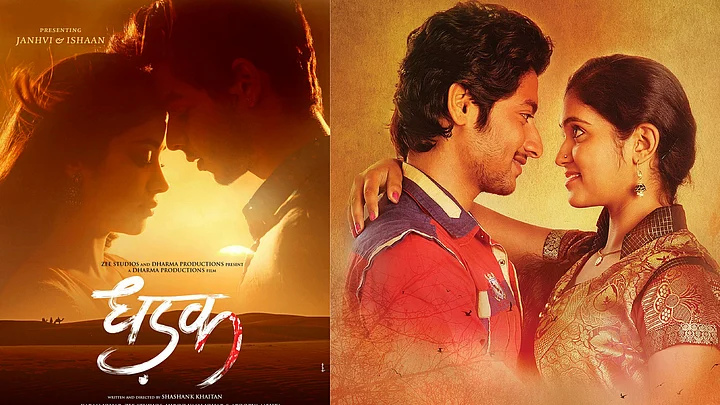Nagraj Manjule’s Sairat made history when it became the highest grossing Marathi film ever, entering the Rs 100-crore club. The major draws of the film were the the chart-bursting music by Ajay-Atul and the untrained lead actors, Rinku Rajguru and Akash Thosar.
But the beating heart of the film is the narrative that lulls us in with mainstream tropes only to smack us in the gut with the uncomfortable social reality of caste. A doomed love story unfolding in the interiors of Maharashtra, Sairat tells the story of Archi, the indulged and plucky daughter of a rich political kingpin and Parshya, a fisherman’s son, from the Pardhi community, living in a Dalit Ghetto.
It ran in cinema houses for over 100 days in Maharashtra. Not just a film, Sairat became a phenomenon – a part of the Marathi popular culture. No wonder then that the remake rights were procured like hot cakes in many languages. Karan Johar, whose forte has been contemporary, urban, larger-than-life romance, also joined the fray. Now that the first posters of Dhadak are out, the virtual universe of social media that is quick to dole out judgements is rife with speculation. Twitterati has already decided the fate of the film.
Going by the precedents set by the ‘Dharma’ world, the fear that a lot could be lost in translation is not unfounded. But then, this is also the same producer who gave the industry the gift of Alia Bhatt with Student of The Year. Mirroring the vulnerability of her characters with élan, she can make you bawl when she breaks down on screen and that’s no mean feat. So, let’s not rule out surprises yet.
This is also the director/producer who has come a long way since Kuch Kuch Hota Hai, travelling from the ideal and cloying family in Kabhi Khushi Kabhie Gham to the dysfunctional and believable family in Kapoor and Sons. The possibilities that this evolution holds deserve to be mined.
As someone who straddles the twin passions of hard-core song and dance Bollywood movies as well as world cinema, I found the perils and prospects of a Sairat with star kids, Jahnvi Kapoor (Sridevi’s daughter) and Ishaan Khattar (Shahid Kapoor’s brother) worth deconstructing.
It is in the context of Sairat that the debate of nepotism finds great resonance. Manjule chanced upon Rinki Rajguru and Akash Thosar in the unlikeliest of places. When Thosar was a fledgling wrestler, a random coincidence led to Manjule being shown his photograph on a railway station. Rajguru on the other hand was starry-eyed while accompanying her mother to see a ‘film shooting’ in Akluj village of Solapur. She caught Manjule’s eye and an audition followed. The duo that came out nowhere became subjects of adulation, overnight. Their obscurity lent the film the realism that the script demanded.
Sairat wears its politics on its sleeve but makes a tonne of points without being didactic. The casting itself is revolutionary – a girl far from size zero and a non-macho boy with a diminutive frame. Manjule even reportedly asked Rajguru to pile on a few kilos to look convincing.
On the other hand, even before their appearance in the film, the paps made sure that the lead pair of Dhadak were overexposed. The posters of Dhadak expectedly forgo the grimy fervour of Sairat for glamour. A wildly successful remake also seems like an unfair burden on the shoulder of debutantes.
Even in case of Dharma Productions’ OK Jaanu, the remake floundered because of the casting – Shraddha Kapoor and Aditya Roy Kapur could not convey the effortless charm and intensity of Dulquer and Nithya in O Kadhal Kanmani. Amateur debutantes, a shoestring budget of 4 crores, a Dalit filmmaker and a regional milieu were Sairat’s bulwarks. Take one out and the house of cards could collapse.
Sairat’s triumph lies in blending two narratives – the mainstream Bollywood narrative in the first half and the arthouse rendering in the second half. Archi and Parshya’s courtship unfurls in a setting where Bollywood rarely treads – wells, sugarcane fields and rural nooks in the hinterland of Solapur. It is the miniscule social observations like a politician’s son cutting a cake with a sword, highlighting entitlement, that make Sairat a masterpiece. Director Shashank Khaitan’s back-to-back hits, Humpty Sharma Ki Dulhaniya and Badrinath Ki Dulhania set in small-town India made him the director of choice but going by his previous outings, he sacrifices nuances that make his films only superficially progressive.
Good remakes are not frame-to-frame replicas but one can hope that Khaitan imbibes the spirit of Sairat and dismantles structures. Hope we can finally have a KJo masala movie that is socially conscious in an unprecedented way.
(Breathe In, Breathe Out: Are you finding it tough to breathe polluted air? Join hands with FIT in partnership with #MyRightToBreathe to find a solution to pollution. Send in your suggestions to fit@thequint.com or WhatsApp @ +919999008335)
(At The Quint, we question everything. Play an active role in shaping our journalism by becoming a member today.)
